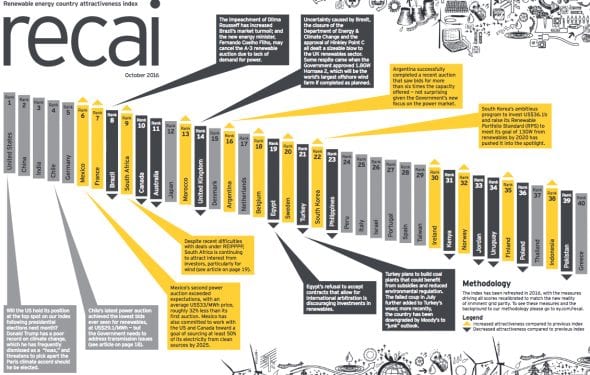Less than one year after resuming top 10 status in the global renewable energy investment “attractiveness” stakes, Australia has flunked out again, according to the latest edition of the rankings from Ernst&Young, released this week.
EY’s October 2016 Renewable Energy Country Attractiveness Index (RECAI) was published on Thursday, revealing Australia has fallen to 11th position, having made it to number 10 in May, up from 13th in September 2015. Directly ahead of Australia is Canada, South Africa and Brazil, while the US, China and India rank numbers 1, 2 and 3, respectively.

The October RECAI report offers no direct analysis of Australia’s backwards step, but according to Matt Rennie – EY power and utilities leader for Oceania – it reflects “both an absolute and relative movement.”
“In an absolute sense, the RET has provided a clear indication to the market that there will be a huge volume of future deals over the next five years and has put Australia on the map as a serious destination for future development, EPC and financing activity,” Rennie said in comments emailed to RE.
“In a relative sense, however, we are of course competing for attention with developing markets such as Mexico and India and with the Middle East who are all releasing large tenders for new renewable capacity.
“It’s important that we work through current issues around PPA terms, and that governments continue to take an active role in facilitating investment through accelerating any land, permitting and policy uncertainty issues,” he said.
“How far up the rankings Australia advances relative to other investment destinations will be the litmus test for how well we meet these challenges.”
And that’s the kicker. In a separate EY report, commissioned by the Clean Energy Regulator to gauge Australia’s progress on the RET, the level of firmly committed new-build renewables was noted at well below the 3,000MW market watchers had hoped to see by now, and finance appeared still to be constrained, with most of the funding for projects coming from governments or government-owned entities.
“Even allowing for transaction activity being a lag indicator, the (data) suggests that, despite the stability of the RET and the stated intentions of retailers, there are commercial investment constraints which could be creating barriers to funding greenfield projects,” the recent EY report said.
In May, EY had credited Australia’s modest rise in rankings to the pressing need to meet its 33,000GWh 2020 renewable energy target after “many months of uncertainty” and “little progress” during 2014-15.
The report also noted that Australia’s prolonged renewable energy policy uncertainty, and the effect this has had on the sector’s ability to secure long-term power off-take agreements, was holding back a “mountain of global cash” looking for investments.
Indeed, Australia still has a lot of ground to make up, having falling from the heady heights of #4 position on the RECAI in 2013, just before Tony Abbott’s Coalition burst onto the political scene, to 13th spot, and now 11th.
In May, EY’s RECAI report pointed to a number of factors behind Australia’s lingering PPA roadblock, including prolonged policy uncertainty, price slumps in Large-scale Generation Certificates (LGCs), vertical integration and the short tenor of the retailers’ own commercial and industrial customers, that have led to few long-term PPAs being signed with third-party developers.
Overall, it noted, “with declining time before the RET ends in 2030, the case for long-term PPAs for 15 years or more appears increasingly difficult without long-term policy certainty.
“Ultimately, more far-reaching energy policy measures will be critical to take Australia’s renewable sector beyond recovery and into long-term growth,” it said.
But Australia’s bounce back down to 11th spot on the Index suggests the policy picture is not brightening up as quickly or convincingly as was hoped under Prime Minister Malcolm Turnbull.
In its October 2016 report, EY notes that global trends reveal companies increasingly striking power purchase agreements directly with renewables projects to meet sustainability goals and avoid power price volatility.
This trend was also flagged in a December 2015 report by McKenzie Baker, based on a survey of senior executives that showed a growing number of businesses were entering offtake deals to buy renewable electricity directly from independent generators, as well as investing in generation assets instead of buying power direct from utilities.










